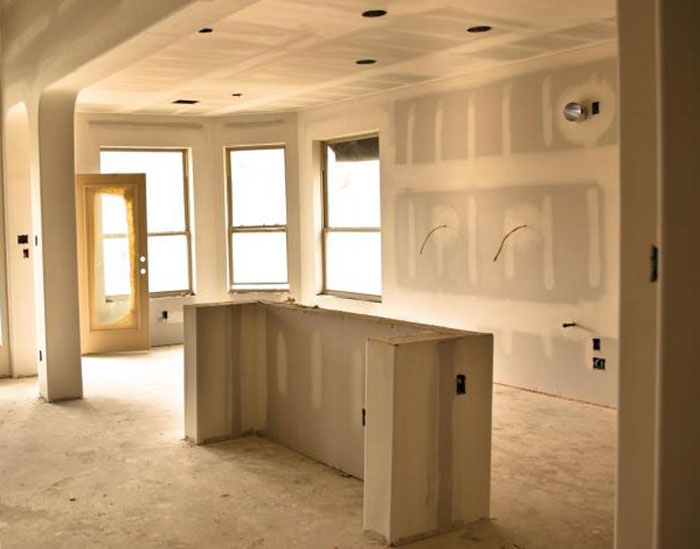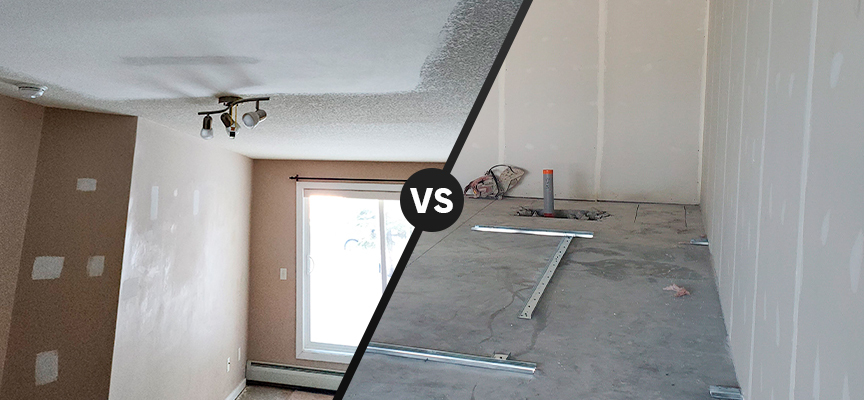Vital Tips for Effective Drywall Fixing and Installment Strategies
Reliable drywall fixing and installment calls for a careful strategy. Understanding the kinds of drywall and having the right devices is important. Exact dimensions and proper methods can greatly influence the end result. Lots of overlook essential actions like taping and sanding, which can make or damage the final look. As projects progress, usual difficulties may occur that require interest. Checking out these suggestions can bring about a much more successful and polished finish.
Recognizing Different Kinds of Drywall
Recognizing the different kinds of drywall is crucial for any kind of successful repair work or setup job. Drywall, commonly referred to as gypsum board, comes in a number of varieties tailored for particular applications. Standard drywall is the most extensively made use of type, ideal for basic interior walls and ceilings. Moisture-resistant drywall, commonly environment-friendly in color, is developed for areas vulnerable to moisture, such as restrooms and cooking areas. Fire-resistant drywall, generally colored pink or purple, is crafted to hold up against higher temperature levels and is usually used in garages or near furnaces. Additionally, soundproof drywall aids reduce sound transmission, making it ideal for multi-family homes or recording studios. Specialty drywall, like concrete board, is made use of in damp locations like showers or tub surrounds. Recognizing these kinds assists in choosing the appropriate product for each task, ensuring resilience and performance in repair services or new installations.
Necessary Devices for Drywall Repair Work and Setup
Having the right devices is essential for effective drywall repair work and setup. A high quality utility knife is crucial for cutting drywall sheets precisely. A drywall T-square assists ensure straight sides, while a taping blade is essential for using joint substance efficiently over seams. In addition, a drywall saw permits for eliminating damaged areas or fitting drywall around fixtures.
For hanging drywall, a power drill with drywall screws is indispensable, as it makes it possible for fast and safe and secure installation. A level is additionally crucial to confirm that the drywall is straight and effectively aligned. A sanding block or post sander is vital for raveling joint substance once it has actually dried out. A gauging tape is essential for exact measurements, protecting against waste and making sure a proper fit. Equipped with these tools, people can deal with drywall tasks efficiently, leading to professional-looking outcomes.
Step-by-Step Overview to Fixing Holes and Cracks
When attending to openings and fractures in drywall, having the right tools and products is important for an effective repair. This overview lays out the required products and supplies a clear, step-by-step process to properly restore the surface area. Recognizing these components will certainly aid guarantee a seamless coating and durable results.
Devices and Materials Needed
A fully equipped toolkit is essential for reliable drywall repair work and installment. Secret tools consist of an energy knife for cutting drywall, a tape step to ensure exact sizing, and a drywall saw for bigger holes. A putty blade is crucial for applying joint substance smoothly, while a sanding block or post sander assists accomplish a seamless surface. For patching, a roll of fiberglass fit together tape or paper tape is necessary to enhance joints. In addition, a drill and screws are needed for securing new drywall pieces. Vital products include joint substance, guide, and paint to finish the repair. Having these tools and materials available guarantees a smoother, more effective repair process, yielding professional-looking results.
Repair Work Process Actions
Fixing holes and cracks in drywall calls for a methodical approach to guarantee a seamless coating. The location surrounding the damage ought to be cleansed thoroughly to get rid of dirt and debris. Next, for tiny cracks, a putty blade is utilized to use a joint substance evenly over the location. For bigger holes, a spot is essential; the harmed area is cut out, and a brand-new piece of drywall is fitted in location, protected with screws. As soon as the spot is in position, joint compound is put on blend the edges. After drying out, fining sand the location smooth is necessary. The repaired surface must be primed and repainted to match the surrounding wall, guaranteeing an unnoticeable repair service.
Methods for Putting Up Drywall Panels
Installing drywall panels needs cautious preparation and precise execution to ensure a expert and smooth surface. It is essential to measure the wall room accurately and cut the panels to fit, ensuring that they line up with the studs. Placing the panels flat is usually recommended, as this can boost the structural stability and lower the variety use this link of joints.
Utilizing drywall screws, installers ought to protect the panels every 16 inches along the studs, guaranteeing a company hold. It is crucial to prevent overdriving the screws, which can harm the paper surface area. For edges and edges, using an utility blade enables clean cuts and a tight fit.

Finishing Touches: Insulation, Mudding, and Sanding
When the drywall panels are securely in position, the next essential step involves the complements of taping, mudding, and sanding. Insulation is essential for producing a seamless shift in between panels and hiding joints. A high quality drywall tape, either paper or fiberglass harmonize, need to be used over the seams, guaranteeing it sticks properly to the mud that will be applied next.
Mudding, or applying joint compound, complies with the taping procedure. This substance fills up spaces and ravel the surface. A first layer should be used generously, feathering the edges to mix with the drywall. After the first layer dries out, succeeding layers might be needed for a remarkable coating.
Ultimately, sanding is necessary to achieve a smooth surface. A fine-grit sandpaper needs to be used to delicately smooth out any imperfections. Treatment needs to be required to avoid over-sanding, which can damage the drywall - drywall contractors. Effectively executed, these ending up touches produce a specialist look all set for paint
Tips for Preserving Your Drywall After Installment
Preserving drywall after installment is crucial to maintaining its look and architectural stability. Routine cleaning is essential; dirt and dust can gather, so gentle cleaning with a moist towel is suggested. House owners ought to additionally inspect for any indicators of moisture or mold and mildew, especially in high-humidity areas like bathrooms and cooking areas. If any type of damages happens, it is necessary to address it quickly to avoid more issues.
Making use of furnishings pads can aid stop scrapes or damages from heavy things. Additionally, repainting the drywall with a top quality, cleanable paint offers an additional layer of security and makes future cleaning simpler. Prevent using unpleasant cleansers or tools, as these can damage the surface. Maintaining a stable indoor climate with suitable moisture degrees will certainly assist prevent splitting or contorting over time. By adhering to these ideas, one can guarantee that drywall remains in exceptional condition for years to come.
Regularly Asked Questions
For How Long Does Drywall Require To Fully Dry After Installation?

Can I Set Up Drywall Over Existing Drywall?
Yes, drywall can be installed over existing drywall, however it is crucial to ensure the underlying surface is secure and effectively prepared. This approach can boost insulation and lower installation time, though it may add weight.
What Is the very best Way to Soundproof Drywall?
The very best means site to soundproof drywall involves making use of specialized soundproofing materials, such as resistant networks, acoustic caulk, and sound-dampening drywall. These methods effectively decrease audio transmission between areas, improving overall acoustic look at this web-site efficiency in living spaces.
How Do I Select the Right Drywall Thickness?
To pick the ideal drywall thickness, consider the application and location. Criterion domestic wall surfaces normally utilize 1/2 inch, while ceilings or specialized locations might need 5/8 inch for added toughness and soundproofing abilities.
Are There Eco-Friendly Drywall Options Available?
Yes, environmentally friendly drywall alternatives are available. These consist of products made from recycled products, plaster boards with low unstable natural compounds (VOCs), and those using sustainable manufacturing processes, offering environmentally-conscious selections for building and remodelling tasks.
Having the right devices is vital for effective drywall repair work and installment. For hanging drywall, a power drill with drywall screws is essential, as it makes it possible for quick and secure installment. Trick devices include an utility blade for reducing drywall, a tape measure to guarantee precise sizing, and a drywall saw for larger openings. Yes, drywall can be installed over existing drywall, however it is vital to ensure the underlying surface is safe and secure and properly prepared. The finest way to soundproof drywall entails utilizing specialized soundproofing materials, such as resilient channels, acoustic caulk, and sound-dampening drywall.